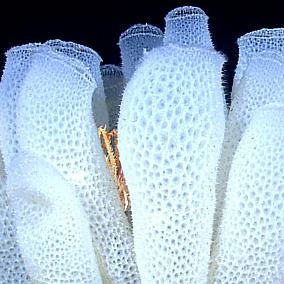
1 minute read
Venus flower basket sea sponge
from Pretsolia Graphic Standard
by tkoga
Biomimicry Venus’ Flower Basket Sea Sponge
Overview
Advertisement
The Venus’ flower basket (Euplectella aspergillum) is a rare deep ocean floor marine animal. The tube-shaped sponge filters miniscule food particles from the seawater as it flows through the structure. The cylindrical skeleton, composed of silica, the main component in glass has a tough composition with over six levels of organization. The top cap prevents the structure from collapsing. This sea creature is most commonly found in the deep waters off the coast of Asia.
Properties
The sea sponge thrives at deep ocean depths since the stiff lattice like structure and round shape counter the strong ocean currents. The silica spicules on the exoskeleton bend and are notable for their ability to absorb stress at intersecting points on the structure. The hollow basket of the sponge allows both water and nutrients to flow and simultaneously filter though the complex lattice structure.
Design Application
300 St Mary Axe in London, commonly known as “The Gherkin,” designed by Foster + Partners, has a grate-like exoskeleton that mimics the structure of the Venus’ flower basket sea sponge. The skeleton was designed make the skyscraper’s ventilation system mimic the nutrients flow system of the sea sponge. The lattice-like exoskeleton structure directs airflow from the street level and from open windows along the spiral frame to the offices. The natural flow of air reduces around half of the need for air-conditioning in the skyscraper. The cylindrical design improves the ventilation and is engineered to have a similar structure to the sea sponges. The round shape reduces wind forces since air can flow around the building. This technique can help reduce greenhouse gasses in future architectural designs. The structure is ideal for stable structures and packaging.

Sources

1. Dearen, Jason. “The Buildings Are Alive: in Biology, Designers and Architects Seek Answers.” ZDNet, ZDNet, 24 May 2012, www.zdnet.com/article/thebuildings-are-alive-in-biology-designers-and-architects-seek-answers/. 2. Knight, J.D. “Deep Sea Sponges: Sea Gallery on Sea and Sky.” Sea and Sky, www.seasky.org/sea-gallery/sea-gallery-08-23.html. 3. Massey, Jonathan. “The Gherkin: How London’s Famous Tower Leveraged Risk and Became an Icon.” ArchDaily, 12 Nov. 2013, www.archdaily.com/447205/ the-gherkin-how-london-s-famous-tower-leveraged-risk-and-became-an-icon part-2. 4. “Silica Skeleton Is Tough and Stable : Venus’s Flower Basket.” AskNature, asknature.org/strategy/silica-skeleton-is-tough-and-stable/#.XK_8QZNKj-Y. 5. “Swiss Re Building.” AskNature, asknature.org/idea/swiss-re-building/#.XLALtJNKj-Y.







